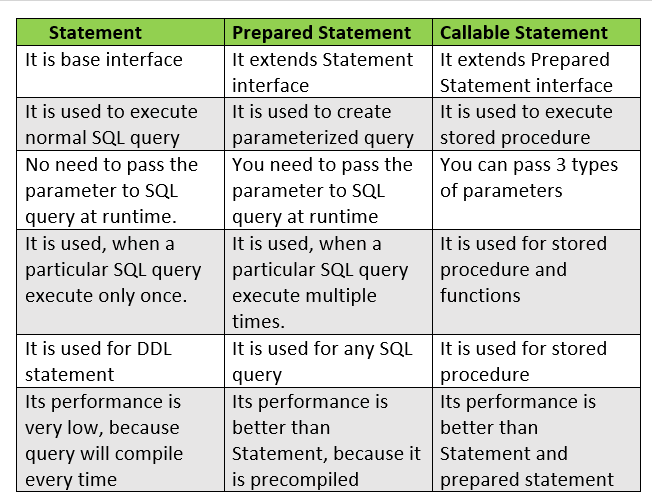
- #SQLITE INSERT PREPARED STATEMENT REAL JULIANDAY JAVA HOW TO#
- #SQLITE INSERT PREPARED STATEMENT REAL JULIANDAY JAVA ANDROID#
- #SQLITE INSERT PREPARED STATEMENT REAL JULIANDAY JAVA CODE#
See the section SQL Injection in Database PL/SQL Language Reference, part of Oracle Database documentation, for more information.ĬoffeesTable. Prepared statements always treat client-supplied data as content of a parameter and never as a part of an SQL statement.
#SQLITE INSERT PREPARED STATEMENT REAL JULIANDAY JAVA CODE#
SQL injection techniques all exploit a single vulnerability in the application: Incorrectly validated or nonvalidated string literals are concatenated into a dynamically built SQL statement and interpreted as code by the SQL engine. PreparedStatement preparedStatement connect.prepareStatement ('INSERT into employee (time, name) VALUES (,)', Statement.RETURNGENERATEDKEYS) tTimestamp (1, new (new ().getTime ())) tString (2, 'Test') preparedStatement.executeUpdate () ResultSet tableKeys pr. Attackers trick the SQL engine into executing unintended commands by supplying specially crafted string input, thereby gaining unauthorized access to a database to view or manipulate restricted data. SQL injection is a technique to maliciously exploit applications that use client-supplied data in SQL statements. However, the most important advantage of prepared statements is that they help prevent SQL injection attacks. Examples of this are in the following sections. The advantage of using SQL statements that take parameters is that you can use the same statement and supply it with different values each time you execute it. To insert data into a table using the INSERT statement, you use the following steps: First, connect to the SQLite database. This means that when the PreparedStatement is executed, the DBMS can just run the PreparedStatement SQL statement without having to compile it first.Īlthough you can use PreparedStatement objects for SQL statements with no parameters, you probably use them most often for SQL statements that take parameters. A PreparedStatement is a pre-compiled SQL statement. As a result, the PreparedStatement object contains not just a SQL statement, but a SQL statement that has been precompiled. The advantage to this is that in most cases, this SQL statement is sent to the DBMS right away, where it is compiled.
#SQLITE INSERT PREPARED STATEMENT REAL JULIANDAY JAVA ANDROID#
Insert multiple values SQLite android with the same query. The main feature of a PreparedStatement object is that, unlike a Statement object, it is given a SQL statement when it is created. WITH RECURSIVE cte(x) AS ( SELECT julianday(date(max(thedate))) from TheDataTable UNION ALL. If you want to execute a Statement object many times, it usually reduces execution time to use a PreparedStatement object instead. This special type of statement is derived from the more general class, Statement, that you already know. Sometimes it is more convenient to use a PreparedStatement object for sending SQL statements to the database.

#SQLITE INSERT PREPARED STATEMENT REAL JULIANDAY JAVA HOW TO#
Statement.executeUpdate("CREATE TABLE charge(username TEXT NOT NULL, date DATETIME DEFAULT CURRENT_TIMESTAMP, charge REAL, PRIMARY KEY(username, date)) ") Last updated: JIn my first Java JDBC tutorial (How to connect to a JDBC database) I demonstrated how to connect your Java applications to standard SQL databases like MySQL, SQL Server, Oracle, SQLite, and others using the JDBC Connection object. Here is the database Java class (the relevant piece) //create the charge table. You can set NULL to 'id' which has NOT NULL because 'id' has INTEGER PRIMARY KEY: INSERT INTO person VALUES (NULL, 'John'), (NULL, 'Tom') Now, you can insert rows as shown below: sqlite> SELECT FROM person id name. Which happens when I call the same preparedStatement a second time. Then, set NULL to 'id' of AUTOINCREMENT as shown below.

This is a bit simpler than creating a connection as, upon failure, no resources are allocated other than perhaps an. If you use parameters for the statement, use a question mark. To insert data into a table using the INSERT statement, you use the following steps: First, connect to the SQLite database. More specifically, the result is a statement handle. Summary: in this tutorial, we will show you how to insert data into a table in an SQLite database using the Java JDBC. SQLite provides the sqlite3preparev2 function to compile a SQL statement and return the resulting statement object.

: The prepared statement has been finalized While connections are opened, statements are prepared.


 0 kommentar(er)
0 kommentar(er)
